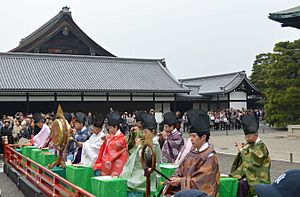Gagaku facts for kids
Gagaku is a very old and special kind of Japanese court music. It's like the classical music of Japan! This music came to Japan from China way back in the 8th century, which is over 1200 years ago. The word "Gagaku" actually means "elegant music," and it really lives up to its name.
Most of the Gagaku music we hear today is called Togaku, which means "music from the Tang Dynasty" (an old Chinese dynasty). Gagaku is performed in two main ways: as music for dances and as concert pieces you can just listen to. Even today, you can hear Gagaku at important events in Japan, like New Year's celebrations or weddings held at Shinto shrines.
Contents
Instruments
Gagaku music uses many different kinds of instruments. These include wind instruments, string instruments, and percussion instruments.
There are three main types of wind instruments:
- The Sho
- The Hichiriki
- The Ryuteki
These wind instruments usually play the main tune or melody of the music.
For string instruments, there are mainly two kinds:
- The Koto
- The Biwa
And for percussion instruments, there are three important ones:
- The Dadaiko (a very large drum)
- The Shoko
- The Kakko
The two huge dadaiko drums are a very colorful and exciting part of a Gagaku performance!
Spirituality
Gagaku music is not just about sound; it also has a deep spiritual meaning. One of the most famous pieces of Gagaku music is called Etenraku, which means "divine music."
This music is meant to bring a feeling of peace and healing to the people who listen to it. The dances performed with Gagaku music are designed to create a sense of elegance and harmony. Gagaku is still performed today at the Emperor's court in Japan, keeping this ancient tradition alive.
Images for kids
-
Jingu-Bugaku at Kotaijingu (Naiku), Ise city, Mie Prefecture
See also
 In Spanish: Gagaku para niños
In Spanish: Gagaku para niños



